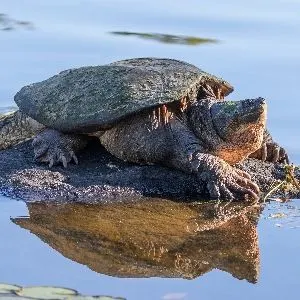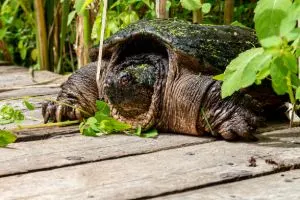For intermediate and advanced reptile keepers, the rewards of Common Snapping turtle care can be incredible. The Common Snapping turtle is one of the most impressive and intimidating species that you could have in your collection. These Jurassic-looking aquatic turtles are big and can be aggressive if they feel threatened.
When considering adding a Common Snapper to your collection, be sure to check whether they are legal in your state. In some areas, Common Snapping turtles are considered an invasive species, so check your local regulations first.
If you can keep a Common Snapper legally, try and adopt one from a rescue shelter if possible. If you are buying a new specimen, make sure to obtain one only from legitimate captive breeders.
Never release your Common Snapper into the wild. This can threaten the local wildlife as Snappers will quickly become the biggest predator in nearby waters. These hardy turtles can thrive in a variety of habitats, and can quickly spread.
In this guide, we’ll take you through the ins and outs of Common Snapping turtle care, from the type of enclosure you’ll need to the right diet and how to handle these powerful turtles safely.
Table of Contents
Common Snapping Turtle Facts

- Experience level: Intermediate to Expert
- Family: Chelydridae
- Scientific name: Chelydra serpentina
- Other names: Common Snapper, Eastern Snapping turtle, Snapper
- Adult Male Size: 10 to 20 inches
- Adult Female Size: 8 to 18 inches
- Average Lifespan: 30 to 50 years
- Average Price Range: $25 to $60
- Books: Snapping Turtle Pet Owners Guide (Ben Team)
The Common Snapper is the state reptile of New York and was officially designated in 2006.
Common Snapping turtles have quite a wide range across much of the United States, except for more extreme southern and western states. Common Snappers found in northern regions tend to be bigger and mature later than those living in southern areas.
In some areas, the Common Snapping turtle is considered to be an invasive species. They have even been found in parts of Italy and Japan, likely due to unsafe release from captivity.
What does a Common Snapping Turtle look like?
Common Snapping turtles are easily identified by their distinctive hooked overbites that resemble beaks. They usually have dark brown or green shells with shallow ridges. They also have strong claws and long tails bearing saw-toothed spines.
How big do Common Snapping Turtles get?
Common Snapping turtles are one of the largest species of turtle native to North America. The average Common Snapping turtle size is between 8 to 18 inches. Females are usually smaller than males. The average Common Snapping turtle weight is around 22 lbs for males. Some exceptional specimens have been recorded at over 35 lbs!
Where do Common Snapping Turtles live?

Common Snapping turtles boast the largest distribution for any North American turtle species. They are native to North America and can be found from southern parts of Canada to the eastern and central United States.
Below is a list of states where the Common Snapping turtle is found as a native species.
The Common Snapping turtle has also been spotted in the following non-native states:
What kind of habitat do Common Snapping Turtles need?

Common Snapping turtles are fully aquatic and rarely venture onto land. They inhabit large, permanent bodies of water, but can also be found in shallower areas. Some Common Snappers even live in the brackish waters of river or tidal estuaries. They prefer waters that have a lot of vegetation.
How long do Common Snapping Turtles live in captivity?
The average lifespan for captive Common Snappers is between 30 and 50 years, although some rare specimens can reach up to 100 years.
What do Common Snapping Turtles eat?
Common Snappers are omnivores, but they mainly eat meat in the form of amphibians, fish, other turtles, and waterfowl. They will also eat aquatic vegetation at times.
In captivity, a good Common Snapping turtle diet should consist of fish, insects, lean meat, mollusks, and worms. Commercial turtle pellets can also be used. Dark leafy greens and vegetables should be offered now and then.
How do Common Snapping Turtles breed?

The breeding season for Common Snappers runs from April to November. Eggs are usually laid in June or July, although females can retain sperm from males for a couple of years before fertilizing eggs.
The only time that Common Snappers move around on land is when females lay their eggs. These are stashed in burrows that are dug into loose, sandy soil. Females can lay as many as 80 eggs a year.
After between three and six months, depending on the climate, the hatchlings emerge from the eggs.
What predators do Common Snapping Turtles face?
The eggs and hatchlings of Common Snapping turtles are the most at risk from predation and can be eaten by birds, raccoons, and other opportunistic mammals. Adult Snappers face very few natural predators but have been known to fall to alligators, bears, coyotes, otters, and even the larger Alligator Snapping turtle.
The difference between Alligator Snapping turtles and Common Snapping turtles
Alligator and Common Snapping turtles can sometimes be confused, but there are some notable differences. Alligator Snapping turtles have much more pronounced ridges on their shells and have bigger heads. Alligator Snappers are also considerably heavier, weighing between 20 to 120 lbs.
Common Snapping Turtle care sheet

Enclosure
Common Snappers need a lot of space in their enclosures. A fully grown Common Snapping turtle will do best in a custom-build outdoor pond measuring about 4 feet long by 2 feet deep. If this isn’t possible, then a 200 to 300-gallon aquarium or ideally a big stock tank or RubberMaid container will suffice.
See our indoor turtle pond setup guide to see what types of setups you could build in place on an aquarium.
Any enclosure should measure at least five times the length of the Snapper’s shell, as these big turtles need a lot of room to swim around in. Baby Snappers can be started in a 20-gallon tank, but they will outgrow it quickly. You will be better off creating the larger enclosure initially or you will end up buying things multiple times.
When decorating the enclosure, provide some form of basking area. Common Snappers won’t bask in the traditional sense of climbing out of the water, but it’s good to give them the option. In most cases, the Snapper will float near the surface of the water and expose its carapace to the sun.
The depth of the water should be at least the length of your turtle’s shell. Provide some aquatic vegetation or large rocks to create some cover for your Snapper.
Recommended basic products
Here is a list of recommended basic products to keep your Common Snapper happy and healthy.
- Tank: Large pond or tub
- Water heater: heater approriate size
- Water conditioner: API Tap water conditioner
- 2 Water thermometers: Vivosun aquarium thermometers
- Combo UVB/UVA (heating) Lighting: Zoo Med PowerSun UV UVB (160 watts)
- Light Fixture: Zoo Med Wire Cage Clamp Lamp
- Timer: Zoo Med Timer
- Thermometer (basking spot): Exo Terra Thermometer
- Laser thermometer for setup and spot checks (optional): Etekcity Lasergrip
- Filtration: SunSun HW-404B (525gph filtration) – See our turtle filter guide for how to choose.
- Automatic Feeder: Petbank Automatic Feeder
Cleaning
Common Snappers prefer slower-moving waters, but will still create a lot of mess. To combat this, you’ll need to use a powerful filter system that can handle at least three times the water capacity of your tank.
For younger turtles such as hatchlings and juveniles, a submersible filter can be sued. But for adult specimens, you’ll need to use an external canister filter. Any equipment placed in an adult’s tank is likely to get crushed. Partial water changes will also be needed to cut down on bacteria and mess in the tank.
Substrate
Because of the need for a deep tank, a substrate isn’t technically necessary for a Common Snapper. Any substrate used should minimize the risk of impaction, so using rocks that are larger than your Snapper’s head is a good bet.
Temperature

Common Snappers are hardy turtles that can survive in cooler temperatures. To give your Snapper the best possible environment, keep the water temperature somewhere between 74°F and 78°F. If you need to use a water heater, make sure that it has a strong guard on it to prevent damage.
The air temperature of the enclosure should be kept at around 80°F to 85°F. The basking spot should be maintained close to 90°F using a heat lamp or mercury vapor bulb.
Humidity
As a fully aquatic species, the Common Snapper won’t need any special humidity requirements.
Lighting
If your Common Snapper is housed outside in a pond, it will get all the light that it needs from the UV rays of the sun, as long as an area of the pond receives direct sunlight.
If you are keeping your Snapper indoors, you’ll need to provide UV light. This will help keep your Snapper’s shell healthy and allow it to absorb the necessary nutrient. A 5.0 UV bulb works well. Any lights should be kept on a 12-hour day/night cycle.
Accessories

Decorating your Snapper’s enclosure with aquatic plants, logs, and rocks will give the turtle ample places to hide away if it wishes. A basking area is also still good to provide. Make sure to protect any equipment that you place within the enclosure.
Feeding
In captivity, a Common Snapping turtle diet should ideally consist of crickets, strips of fish or lean meat, mollusks such as snails, and worms; bloodworms, earthworms, and mealworms are all good staples. You can also offer your Snapper some commercial turtle pellets.
As omnivores, Snappers will occasionally eat vegetation. In captivity, you can provide this in the form of aquatic plants in the enclosure as well as some dark leafy greens and vegetables in their diet. Adult Snappers should eat every couple of days.
Be careful when feeding your Snapper by hand, as they have long necks and can easily strike. The bite of a Common Snapping turtle is pretty powerful, so avoid putting yourself in the firing line. It’s best to just drop the food into the water and let your turtle eat by themselves.
Temperament and handling

Are Common Snapping Turtles good pets?
If you want a pet turtle that you can handle, a Common Snapper isn’t right for you. These turtles are big and will act aggressively when threatened. Their long necks can allow them to nip you even if you hold the sides of their shells. Snappers will also hiss when angry and can also catch you with flailing claws.
Common Snappers also require quite a lot of space, which can be prohibitive for many keepers. Only experienced turtle keepers should even consider keeping a Snapper as a pet.
If you are set on having a Common Snapping turtle, they can be impressive pets to observe. They may spend most of their time below the surface, but when you do see them, they look powerful and resemble a dinosaur.
While in the water, Snappers can be quite curious and docile. They may investigate you if they see you near the tank and will rarely bite if they feel safe. Some Snappers can form a bond with their keepers and actively interact with them.
Signs of good health

A healthy Snapper will be a good weight, with clear and alert eyes and an aggressive response if handled out of the water. There should be no signs of pyramiding or flaking on the shell.
Health concerns
Common Snapping turtles are pretty durable and hardy and are not affected by many health conditions. Make sure to keep their UV exposure consistent, as a lack of UVB can lead to problems such as Metabolic Bone Disease (MBD). This can cause deformed growth and is very painful.
Respiratory infections can also be an issue for Common Snappers. If you spot signs of runny mucus, water eyes, lethargic movement, and a reduced appetite, get your turtle checked by a specialist vet.
Algae growth on a Snapper’s shell must be cleaned regularly. While the algae aren’t harmful, they can hide infections and injuries. Use a soft brush and clean, tepid water to wash the shell.
Video about the Common Snapping Turtle
Common Snapping Turtle Hatchling Care
Common Snapping turtle hatchlings can grow quickly and will need slightly different care requirements for adults to begin with. Initially, a 20-gallon tank is ideal for a hatchling, but it will quickly outgrow this enclosure.
To promote healthy growth, make sure the hatchling receives plenty of UVB and is kept in water with a temperature between 78°F and 80°F. Hatchlings should also be fed every day, with food cut up into smaller strips so that they can be easily digested.
Frequently Asked Questions about Common Snapping Turtles

Are Common Snapping turtles dangerous?
Although they look intimidating, Common Snappers are only dangerous if they feel threatened. Most of the time, if they feel safe in the water, a Snapper won’t act aggressively and will actually be quite docile.
If they are forcibly removed from the water, a Common Snapping turtle will hiss and try to bite you. Their long necks give them surprising reach, and they can bite you even if you are holding the edges of their shell.
Can a Common Snapping turtle bite off a finger?
Contrary to popular belief, a Common Snapping turtle is unlikely to be strong enough to bite off a finger. There have been no recorded instances of this. Although the Common Snapper has a powerful bite, their jaws aren’t as powerful as a human’s. They may be able to leave a scar, but they won’t take a digit off you.
Can you have a Common Snapping turtle as a pet?
It is possible to keep a Common Snapping turtle as a pet, providing that you are an experienced keeper. Finding a baby Common Snapping turtle for sale shouldn’t be too difficult, but try to adopt whenever possible.
However, the Common Snapper is considered to be an invasive species in some areas and is not a legal pet in every state. Check your state’s laws regarding Common Snappers before trying to purchase one. Here is a list of state’s where owning a Common Snapper is either restricted, requires a permit, or is illegal;
– Arizona
– California
– New York
– North Carolina
– Oregon
– Rhode Island
– South Dakota
– Washington
Conclusion
For the experienced turtle keeper, owning a Common Snapping turtle can be a rewarding experience, if you’re able to accommodate the space required and are comfortable not handling this impressive species. These turtles can be aggressive when threatened and are not recommended for beginners.
In this guide, we’ve covered everything you need to know about Common Snapping turtle care. Hopefully, this guide has helped you to decide whether a Common Snapper is right for you. Just keep in mind to check your local laws, adopt whenever possible, and avoid releasing your Snapper unsafely into the wild!
If you enjoyed this article and are planning to obtain a Snapper for your collection, please feel free to comment down below!

Jamie
Saturday 27th of June 2020
I have a common snapper. He's my night time buddy! My husband started to work over night so me and Snapps became good friends, he began by hanging out with me for a few hours each night to sleeping in my shirt and now around 8am I switch him from my shirt to my bed. I think he sleeps too much though, any advice? I've been working remotely the past few months so he's been with me working all day(in my shirt or bed, pending the day) but I have to force him awake at 6/7pm when he goes in my shirt at night no later than 10/11 at night. He only spends 4 hours in the water and that's too eat.. Im not sure I feel like him sleeping from 10pm to 7pm the next day is excessive..... Is it? He eats veryyy well and doesn't have any issues going to the bathroom so am I over reacting? He's about 3 years old and his shell is 11 inches long. Thanks in advance for any help! I feel like a paranoid momma!!
Corwin
Wednesday 18th of March 2020
So I have a baby snapper his name is squirt, and I was told they are strictly carnivorous and can't eat mealworms due to high calcium , I just wanna know for sure what to feed him so I can keep him happy